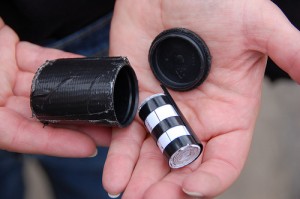6/30/18:
As I (Ally) have been going through and updating the website I have found that this article is FULL of information for New and Seasoned cachers alike.
Thanks Bruce for another great and time tested article.
I thought I would open up the discussion dealing with cache ownership. So many people start off geocaching and after finding one or two caches decide that they know the perfect spot and then try to place one, not understanding what it takes to be a cache owner.
Being a cache owner is more than skimming the requirements and being able to fill out an online form, it takes more time than many people think.
Coordinates:
Many cachers joke about certain hides and hiders saying that they drive down the road and mark a way-point as they toss the cache out of the window. While I hope this isn’t true, having good coordinates takes time and effort. I started off putting my GPSr at the location for the cache and then walking away letting it settle, then marking the way-point. I would then walk away with the GPSr in my hand and then come back to the spot repeating the process. I’d end up doing this about 4 or 5 times comparing the coordinates each time. I know there are fancy GPSr units that will now do this automatically, but I’m old school. I then have to remember that every GPSr is different. SO, having the correct coordinates is the first piece to having a great cache.
Container:
If you are looking for favorite points this is something that you need to seriously  consider. Even a park and grab or lamp post can be made memorable if you have the right container. For me, sometimes it doesn’t matter, other times it is really important. The biggest part is making sure that whatever you choose the log stays dry. I’m one of those folks who still can’t understand how water can get into a decon container, but I also can see that a new cacher might not know that they need to snap shut to be watertight.
consider. Even a park and grab or lamp post can be made memorable if you have the right container. For me, sometimes it doesn’t matter, other times it is really important. The biggest part is making sure that whatever you choose the log stays dry. I’m one of those folks who still can’t understand how water can get into a decon container, but I also can see that a new cacher might not know that they need to snap shut to be watertight.
Maintenance:
This is really what brought me to this post. It seems like so many times cache owners place and then forget. I fall into this category sometimes just because I can’t find the time to go out and replace a wet log. This is what being a cache owner is all about. When you place a cache that cache still needs some TLC. I once had a cache on the campus of ISU in Terre Haute, I was teaching a group of people about caching and they thought it would be cool to place one, so we did. I live two hours away and was the listed owner. Every time something went wrong, I had to figure out when I would have time for a 4 hour trip to check on it. I thought the once a year check up would work, but, caches don’t work on your timetable. When you have absolutely no free time is when the Geo-tour bus stops and 100 people complain about the log being full, or wet. When I had a note about bees inhabiting ground zero I decided that maybe it was time to archive it. The stings I got as I removed the container were a badge of honor and a lesson well learned. So, decide as you find that perfect location can you get there in a timely manner or know someone nearby who could check on it for you.
Other cachers can mark a cache as “Needs Maintenance” which is a nice way to say, go and check this out. Some cachers overuse this power (remember: “With great power comes great responsibility” – Ben Parker) and will mark it for any minor issue. I tend to put those minor things in the log or email the cache owner directly.
Many cachers take it upon themselves to help out the cache owner when it comes to maintenance and as a CO I must say I do appreciate it in most cases. The logs that say replaced wet or full log bring a smile to my face. It’s nice that many folks keep supplies in their cache bag to keep a cache going. This can be taken to extremes, sometimes, with positive and negative results. I think every caching community has tales of cachers who replace “lost” containers when they can’t find them, only to have the next cacher post that they found two containers and weren’t sure which was the real cache. The best rule when it comes to major cache maintenance like this is- don’t do it. OK, OK, for every rule there is are exceptions- If you found the cache container and it was in pieces, replace it and contact the cache owner. If you are going to find a cache that you’ve already found with a friend and it isn’t where you know it was… this is a grey area. After a good search of the spot I’d probably replace it and again, contact the cache owner. While you may think you are helping out, replacing a lost container can cause a lot of confusion. A DNF is not saying your too stupid to find the cache. It’s a message to the cache owner that something may be wrong.
Disabling a Cache:
When you don’t have time to get right out there and check, your obligation to your fellow cachers is to disable the cache. I follow a couple simple rules in order for me to disable a cache- if someone reports there is something dangerous happening (like bees) or if I have multiple DNFs on the hide. The DNF rule is flexible. If the hide is a lamp post and the person who DNF’d it has less than 50 finds I’ll ignore it since they may have never seen this kind of hide before. Someone with 1,000 finds can’t find it I disable the cache and when I have time go out and check on it. When you disable a cache two things happen- first the cache vanishes from pocket queries so other cachers will stop looking for it. Second it is added onto a list for the Reviewers to politely remind you about after a certain amount of time – in the past it was at least a month (more than enough time to fix it).
Archiving a Cache:
Sometimes it’s just time to pull a cache. Maybe it’s because it has been repeatedly muggled, maybe it’s just time to add something new to the area. While longevity of caches can be important- take MINGO as an example of keeping a cache going and The Mission 9: Tunnel of Light as an example of the time had come… I do appreciate that CYBret kept “Get A Life” active long enough for me to find it and even replace the container (which days later got muggled), in most cases the owner has their reasons and they have two options, first to archive and second to let another cacher adopt the cache. Adoptions tend to happen more when a cacher has moved out of the area or given up caching (Yes, it happens sometimes). I adopted a cache that I was FTF on, only to have to archive it later when I couldn’t find an appropriate container to replace it.
Thoughts?
Use the comments below to add your thoughts about Cache Ownership- When do you think someone should start considering hiding their first cache? What about how long a cache owner should wait before checking on a DNF’d cache? How often should a Cache Owner check on their caches? I’d love to hear your thoughts because we all come at it with different experiences.

Excellent article !
And I hope you’ll be willing to help me find someone who loves near Lawrenceburg, Indiana who might place a cache on our property ( the Vance-Tousey House, home of the Dearborn County Historical Society – 508 High St.) Thanks !